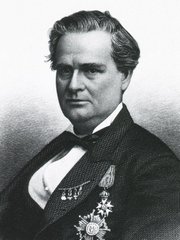|
J. Marion Sims (1813 – 1883). American surgeon and gynecologist. James Marion Sims is considered the “Father of Gynecology". He was born in Hanging Rock, South Carolina. At age 12 he moved to Lancaster, South Carolina. Sims studied at the SC College and later moved to Philadelphia, PA where he studied Medicine at the Jefferson Medical College, graduating in 1835. He returned to Lancaster to practice, but shortly after moved to Montgomery, Alabama.
In 1845 Sims started his studies to close vesicovaginal fistulas, operating in the same patient many times. He was finally able to do this using a lateral recumbent position (later called Sims’ position) and a specially designed, U-shaped, vaginal retractor (later called Sims’ speculum). For this procedure he used silver wire as suture material. His findings were published in 1852 in his paper entitled “On the Treatment of Vesico-Vaginal Fistula”
After moving to New York J. Marion Sims helped in the founding and establishing the Woman's Hospital in the State of New York in 1855. Sims moved to Europe during the American Civil War. In Europe he became well-known and in 1866 published his book “Clinical Notes on Uterine Surgery”. While in Paris Sims performed the first cholecystostomy to relieve a blocked gallbladder.
|

Original image courtesy of NLM
|
| He continued his contribution to gynecology advancing uterine prolapse surgery, advocating hysterectomy for bleeding fibroids, and suggested total hysterectomy as the only means of curing uterine cancer. One of his last contributions (not well accepted initially) was the indication for immediate exploratory laparotomy in abdominal gunshot wounds, burst ectopic pregnancy and any other sharp abdominopelvic trauma.
Sims died in New York on November 13, 1883
Sims’s life was and still is the cause of controversy. His use of slave patients, his professional jealousy and egotism, and his more than once reported disdain for patient privacy would not be accepted by today’s standards. Today in Lancaster his name helps the community thorough the “J. Marion Sims Foundation” dedicated to “support prevention and educational programs that help the citizens of Lancaster and the communities of Great Falls and Fort Lawn”
Sources:
1. “The Influence of J. Marion Sims on Gynecology” Heaton CE Bull N Y Acad Med 1956 32 (9): 685–688
2. “J. Marion Sims, the Father of Gynecology: Hero or Villain?” Sartin, JS South Med J 2004;97(5):500-505
3. “J. Marion Sims: A Defense of the Father of Gynecology” O’Leary JP South Med J 2004;97(5):427-429
4. “Carl Langenbuch and the First Cholecystectomy” Traverso LW Am J Surg 1976; 132; 81-82
|



